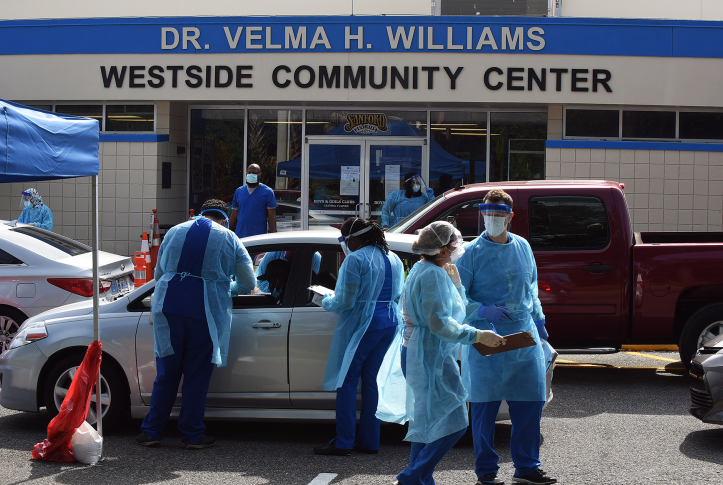The COVID-19 pandemic has highlighted the impact of the chronic underfunding of the U.S. public health system. Despite research showing that investing in public health leads to better outcomes and calls for greater investment in public health, per capita spending before the pandemic totaled less than 3 percent of total health care spending.
During the pandemic, Congress passed relief and recovery bills addressing acute workforce shortages and enhancing disease mitigation strategies. But it has not yet advanced forward-looking investments to strengthen the public health infrastructure, reimagine the public health workforce, and prepare for future pandemics.
Here we describe federal policies currently under consideration as part of the Build Back Better Act (BBBA) that could address these concerns.
Core Public Health Infrastructure
The BBBA would invest in core public health infrastructure to bolster the public health system and address existing problems. “Core public health infrastructure” refers to activities that strengthen the quality and capacity of a health department to address a range of issues, such as infectious and chronic diseases or environmental hazards. These activities can include upgrading surveillance systems to identify unmet population health needs or emerging health threats, developing science-based policies to guide public health practice, and conducting public health education campaigns. The BBBA would provide:
- Grants and awards for health departments. State or territorial health departments, local health departments serving counties of at least 2 million or cities of at least 4 million, and Tribe or urban Indian health organizations would receive an award for core public health infrastructure needs. The BBBA includes $300 million in 2022, $450 million in 2023, and $1.5 billion for 2024–2026. By supporting cross-cutting capabilities, these grants would enhance the impact of activities funded by the Centers for Disease Control and Prevention (CDC) in states and territories.
- CDC funding. The BBBA also includes $100 million in 2022, $150 million in 2023, and $500 million in 2024–2026 to support public health activities at the CDC.
Additional policies would further strengthen our response to COVID-19 and future pandemics by providing funding for preparedness and response. Provisions under consideration include:
- Public health laboratories. The package includes $1.4 billion for the CDC to expand and modernize state and local public health laboratories. These activities would improve testing and response capacity, genomic sequencing of pathogens, and biosecurity capacity. The BBBA also would expand the number of labs that participate in the Laboratory Response Network, which aims to respond quickly to biological and chemical threats and other public health emergencies.
- Public health emergency response. The BBBA would provide $1.3 billion in funding for the Office of the Assistant Secretary for Preparedness and Response to:
- support hospital surge capacity
- develop and procure active pharmaceutical ingredients, vaccines, diagnostic technologies, medical devices, and other projects for the national stockpile, as well as activities to mitigate supply chain risks
- aid expanded vaccine production capacity
- fund activities conducted by the Biomedical Advanced Research and Development Authority for research, standards development, and domestic manufacturing capacity for drugs
- promote increased biosafety and biosecurity in research supported by the U.S. Department of Health and Human Services.
- Food and Drug Administration infrastructure. The Food and Drug Administration would receive $150 million to improve technology infrastructure and an additional $150 million to modernize laboratories.
The BBBA also would invest in training additional health care workers to bolster the capacity for delivering both health care and public health services, particularly for low-income Americans. This has important equity implications, as many Black and Latinx communities currently have limited access to primary care providers and high-quality health care facilities.
What’s Next for Public Health in Congress
Pandemic preparedness and response, stabilizing the public health workforce, and investing in core public health infrastructure components have emerged as top priorities for many policymakers. In addition to the polices under consideration in the BBBA, the Chair of the Senate Committee on Health, Education, Labor and Pensions Patty Murray (D–Wash.) and Ranking Member Richard Burr (R–N.C.) announced in April 2021 a bipartisan effort to develop comprehensive pandemic preparedness legislation, which may evolve into a reauthorization of the Pandemic and All-Hazards Preparedness Act. The current authorization expires September 30, 2023. In November 2021, Reps. Diana DeGette (D–Colo.) and Fred Upton (R–Mich.) introduced the Cures 2.0 Act, which includes a range of public health–related initiatives such as developing a nationwide testing and vaccine distribution strategy for future pandemics. Additionally, to address workforce needs, Congress will have to reauthorize funding the National Health Service Corps and the Nurse Corps, as funding expires at the end of 2023 and 2024, respectively.
COVID-19 has exposed the cracks in our public health infrastructure and the need to make sustained investments to better respond to future emergencies and pandemics. Congress has legislative vehicles available to ensure that the lessons from COVID-19 can be leveraged to improve public health for the long term.







